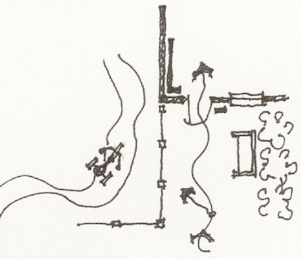Master’s Thesis
 Reinforcing, Inquiry, Knowledge, and Understanding through Architectural Form in Pre-Kindergarten Learning Environments
Reinforcing, Inquiry, Knowledge, and Understanding through Architectural Form in Pre-Kindergarten Learning Environments
Abstract
Without the art, aesthetic, or psychological manifestation in architectural from the building of a school is a waste of time, space, and material resources. The architecture of schools should support the psychological as well as the physical needs of children, parents, staff, and the community therefore increasing the potential for learning. This thesis supports a school architecture which plays an active role in the process of learning, influencing the experience and therefore this thesis supports an engaging psychologically based school architecture.
The architecture of a pre-kindergarten school must embrace the significance placed upon the structure, it’s meaning and symbolic expression, and its signified meaning must specifically support the psychological needs of the children learning within. A theory of significance that will displace conventional school architecture and challenge the methodological assumptions of architectural historiography.
Children derive knowledge and understanding of themselves from objects in the world, therefore their body, mind and spirit should influence the foundations of the school architecture. In addition, a school architect must not arbitrarily select which problems to approach and which values to address. He cannot exclude important issues, separating architecture from the needs of the child, the administration, the community, and the society. They must intentionally design meaning into their building. It is not an issue of “applying” philosophical systems to architecture in occasional and opportunistic ways, but rather of linking two codes in such a way that each can articulate and interpret the other. Theory supporting practice and practice supporting theory. The opportunity exists to expose and dismantle the existing assumptions that structure school architecture and reorganize these elements in the most liberating ways in an order that is valid and vital to the facilitation of learning and understanding.
As we approach the turn of the new century, a broad array of related circumstances will pave the way for a new approach to design of environments for learning. During most of the nineteenth century, educators have defined the learning environment through curriculum and instruction while architects and planners have been largely concerned with rooms and spaces. The resulting architecture is interchangeable and sterile having the ability to support multiple activities because it influences none. If school architecture is a simple box, large enough to hold 1,000 students, the school system could simply lease space in an urban or suburban office building. As research on the human brain continues to develop, it is becoming clear that the learning environment must embody a rich combination of semiotic relationships that trigger multiple intelligence’s attuned to an abundant variety of emotional intellectual, visual and special stimuli.
Beyond structure, the psychological aspects of architecture can embody the spirit of a child giving a complete meaning to the phrase, architecture serves man. “there is a way of working, sometimes called are, which gives to things made by man qualities of form beyond those demanded by economic, social, or ethical expediency; a way of working which brings harmony with ourselves some part of our environment created by us; which makes that environment, through education, a universal experience; which transforms the science of building into architecture.” What is architecture but “…architecture for man, modeled according to the human scale, according to the spiritual, psychological, and material necessities associated with man. “ Buildings enclose space in ways which may facilitate or inhibit a particular range of activities, filter out the external environment, consume resources and act as cultural symbols, whether one likes it or not. In other words every building creates associations in the mind of the beholder, whether the architect wanted it or not. Created association and meaning should therefore seize its potential and serve children psychologically as well as physically.